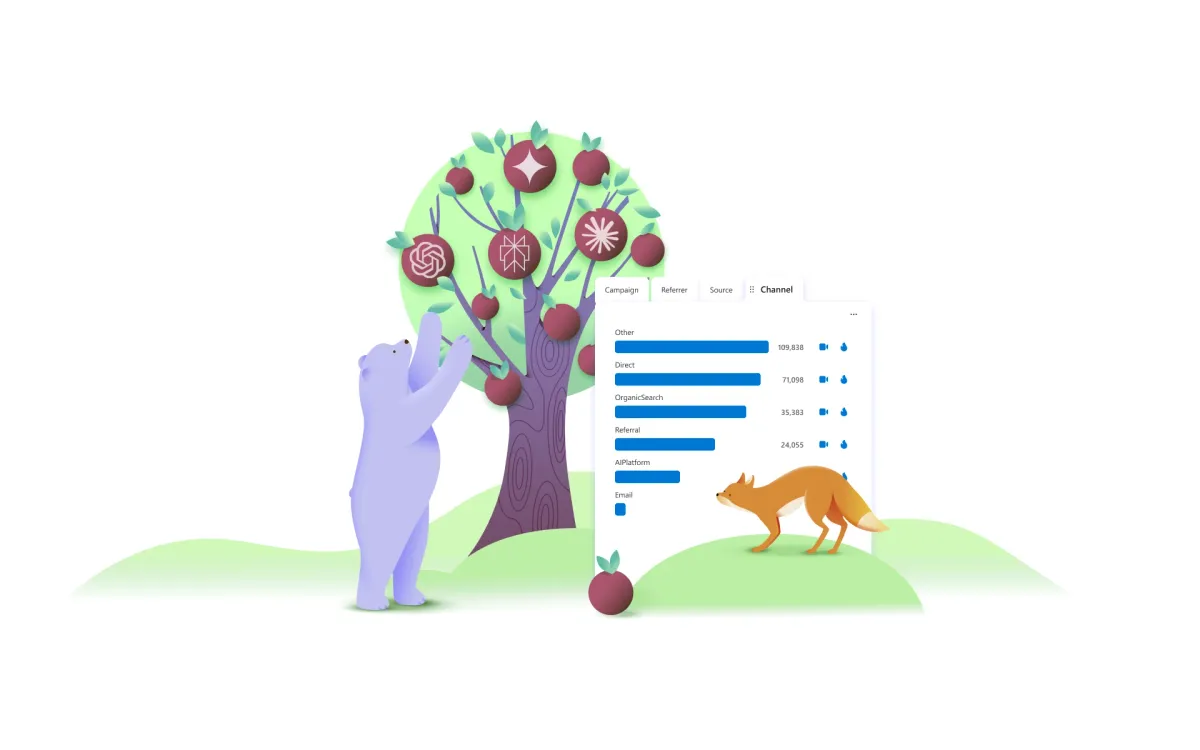AI Insights
Microsoft Clarity introduces AI channel groups for traffic analytics

Microsoft Clarity unveiled two new channel groups on August 29, 2025, specifically designed to track and analyze traffic from artificial intelligence platforms. The AI Platform and Paid AI Platform groups enable website operators to identify, segment, and measure visitors arriving through AI chat tools including ChatGPT, Claude, Gemini, Copilot, and Perplexity.
According to the company’s announcement, industry analysts predict traditional search volume will decline by 25% by 2026 as AI chat tools increasingly serve as gateways to web content. This shift fundamentally alters user behavior patterns. AI-referred visitors typically bypass homepage navigation, land directly on specific pages deep within sites, and demonstrate higher conversion rates compared to traditional search traffic.
The announcement, published on Microsoft’s Clarity blog, addresses significant tracking challenges faced by marketing teams. “Users from AI models don’t behave like traditional browsers,” according to the blog post. These users arrive with specific goals and high intent, requiring different analytical approaches than conventional traffic sources.
Subscribe PPC Land newsletter ✉️ for similar stories like this one. Receive the news every day in your inbox. Free of ads. 10 USD per year.
Technical implementation and functionality
The new channel groups operate within Clarity’s existing analytics infrastructure. The AI Platform group captures organic interactions between users and AI chat platforms, while Paid AI Platform tracks sessions originating from advertisements within AI experiences. Both groups utilize identical source data to ensure consistent reporting across different traffic types.
Website operators can access these features through their existing Clarity dashboard without additional setup requirements. Navigation involves opening the dashboard, selecting the Channels card, and filtering by either “AI Platform” or “Paid AI Platform” to view segmented traffic data.
Microsoft has structured these groups to provide comprehensive session analysis capabilities. The platform records complete user journeys from initial AI platform interaction through site conversion or exit. Session recordings capture navigation patterns, click behaviors, and engagement metrics specific to AI-referred traffic.
Heatmap functionality extends to AI traffic analysis, generating visual representations of where users focus attention after arriving from AI platforms. These visualizations aggregate cursor movements, scroll depth measurements, and interaction patterns to create detailed engagement maps for this specific traffic source.
Market context and competitive positioning
The AI channel groups launch represents Microsoft’s latest expansion of Clarity’s analytical capabilities within an increasingly competitive web analytics landscape. PPC Land has previously documented how Clarity positions itself as an alternative to Google Analytics 4 through its emphasis on behavioral analytics including session recordings and heatmaps.
Microsoft’s approach differentiates from competitors through its free-to-use model without traffic limitations or feature restrictions. The company continues offering enterprise-level analytics capabilities at no cost, targeting organizations seeking comprehensive behavioral insights without subscription fees.
The timing coincides with broader shifts in digital marketing attribution methods. Marketing professionals increasingly recognize that traditional traffic sources provide limited insight into user behavior after initial site arrival. The introduction of AI-specific tracking addresses this analytical gap by providing dedicated measurement tools for emerging traffic patterns.
Buy ads on PPC Land. PPC Land has standard and native ad formats via major DSPs and ad platforms like Google Ads. Via an auction CPM, you can reach industry professionals.
Behavioral pattern analysis
AI-referred visitors demonstrate distinct engagement characteristics compared to search or social traffic. According to Microsoft’s research, these users arrive with higher intent levels and specific objectives, often converting at elevated rates relative to other traffic sources. Their navigation patterns frequently involve deeper site exploration rather than surface-level browsing.
The session recording capabilities enable detailed analysis of how AI-referred users interact with website content. These recordings document complete user journeys including page transitions, form interactions, and conversion funnel progression. Marketing teams can identify specific friction points that prevent AI traffic from completing desired actions.
Conversion path optimization becomes more targeted through AI traffic segmentation. Organizations can compare conversion rates, session durations, and engagement depths between AI platform traffic and traditional sources. This comparative analysis enables data-driven decisions about content placement and user experience modifications specifically for AI-referred visitors.
Integration with existing analytics workflows
The AI channel groups integrate seamlessly with Clarity’s established analytics ecosystem. Organizations using multiple tracking tools can combine AI traffic insights with data from other analytics platforms to create comprehensive attribution models. The consistent data structure enables easy export and analysis across different business intelligence systems.
Cross-functional team collaboration benefits from unified AI traffic reporting. Marketing departments generating AI platform visibility can share behavioral data with user experience teams responsible for site optimization. This integrated approach eliminates data silos that previously complicated campaign attribution and user journey analysis.
Campaign performance measurement extends to AI platform contexts through the new tracking capabilities. Organizations can evaluate how content optimized for AI discovery performs compared to traditional search engine optimization efforts. These insights enable resource allocation decisions based on actual traffic generation and conversion performance.
Privacy and data collection protocols
Microsoft maintains existing privacy standards for AI traffic tracking functionality. The company processes data collection through established frameworks that comply with GDPR, CCPA, and similar privacy regulations. User consent mechanisms remain consistent across all traffic source tracking, including the new AI platform groups.
Data retention policies apply uniformly to AI traffic analytics. Session recordings and behavioral data follow the same storage and deletion protocols as other Clarity tracking capabilities. Organizations can configure data retention periods according to their compliance requirements and business needs.
The technical implementation ensures that AI traffic tracking operates within current security frameworks. No additional user data collection occurs beyond Clarity’s standard behavioral tracking scope. The feature categorizes existing traffic data rather than gathering new user information.
Industry implications for marketing attribution
The introduction of AI-specific traffic tracking reflects broader changes in how users discover and interact with web content. Traditional attribution models based on search engine referrals increasingly fail to capture complete user journeys that begin with AI platform interactions.
Marketing measurement practices require adaptation as AI platforms become primary information sources for consumer research. The ability to track and analyze AI-referred traffic enables more accurate return on investment calculations for content marketing efforts targeting AI platform visibility.
Competitive advantages may emerge for organizations implementing comprehensive AI traffic analysis. Early adoption of specialized tracking capabilities positions companies to understand and optimize for emerging user behavior patterns before competitors develop similar measurement approaches.
Future analytics development trends
Microsoft’s AI channel groups represent part of a broader industry trend toward more sophisticated traffic categorization. The company’s broader AI integration strategy includes previous launches of Copilot functionality for natural language analytics queries and Campaign Insights for advertising performance analysis.
The evolution toward AI-centric web analytics reflects fundamental shifts in user behavior and content discovery methods. Organizations require increasingly specialized measurement tools to understand traffic sources that operate differently from traditional search and social channels.
Advanced segmentation capabilities may expand as AI platform usage grows. Future developments could include more granular categorization of AI traffic based on specific platforms, query types, or user intent levels. Microsoft has previously demonstrated willingness to enhance Clarity features based on user feedback and emerging market needs.
Subscribe PPC Land newsletter ✉️ for similar stories like this one. Receive the news every day in your inbox. Free of ads. 10 USD per year.
Timeline
Subscribe PPC Land newsletter ✉️ for similar stories like this one. Receive the news every day in your inbox. Free of ads. 10 USD per year.
PPC Land explains
AI Platform: Microsoft Clarity’s dedicated channel group that tracks organic sessions from users arriving via AI chat platforms such as ChatGPT, Claude, Gemini, Copilot, and Perplexity. This channel group enables website operators to identify and segment visitors who discovered their content through conversational AI interactions rather than traditional search engines. The AI Platform designation helps distinguish between different traffic sources and their associated behavior patterns, providing insights into how artificial intelligence tools drive website discovery and engagement.
Traffic Analytics: The systematic measurement and analysis of website visitor data, encompassing metrics such as session duration, page views, conversion rates, and user behavior patterns. Traffic analytics enables organizations to understand how users find, navigate, and interact with their websites. Microsoft Clarity’s enhanced traffic analytics now includes specialized tracking for AI-referred visitors, providing granular insights into this emerging traffic source that exhibits distinct characteristics compared to traditional search or social media referrals.
Session Recordings: Digital recordings that capture complete user interactions during website visits, including mouse movements, clicks, scrolls, and page navigation sequences. Session recordings provide qualitative insights that complement quantitative analytics data by showing actual user behavior rather than aggregated statistics. Microsoft Clarity’s session recording capabilities extend to AI-referred traffic, enabling detailed analysis of how users from AI platforms navigate websites differently from traditional visitors.
Microsoft Clarity: A free web analytics platform launched by Microsoft that specializes in behavioral analysis through features like session recordings, heatmaps, and user interaction tracking. Unlike traditional analytics tools that focus primarily on traffic volume and basic metrics, Microsoft Clarity emphasizes understanding how users actually interact with websites. The platform positions itself as a complement to or alternative for Google Analytics, offering unlimited traffic analysis without subscription fees or feature restrictions.
Behavioral Analytics: The study and measurement of user actions and interactions on websites, applications, or digital platforms. Behavioral analytics goes beyond basic metrics like page views to examine how users move through sites, where they encounter difficulties, and what drives conversion or abandonment. This analytical approach helps organizations optimize user experiences by identifying specific friction points and engagement patterns that traditional metrics might miss.
Conversion Rates: The percentage of website visitors who complete desired actions such as making purchases, filling out forms, subscribing to services, or downloading content. Conversion rates serve as key performance indicators for website effectiveness and marketing campaign success. According to Microsoft’s research, AI-referred visitors demonstrate higher conversion rates compared to traditional traffic sources, making specialized tracking and optimization crucial for maximizing these valuable interactions.
User Experience: The overall experience and satisfaction users have when interacting with websites, applications, or digital services. User experience encompasses factors like ease of navigation, page load speeds, content accessibility, and interface design. Microsoft Clarity’s AI channel groups enable organizations to tailor user experiences specifically for AI-referred visitors, who often arrive with higher intent and specific goals compared to browsing-oriented traditional traffic.
Heatmaps: Visual representations of user interaction data that use color coding to show areas of high and low engagement on web pages. Heatmaps typically display click patterns, scroll depth, and attention focus through color gradients ranging from cool colors (low activity) to warm colors (high activity). Microsoft Clarity generates heatmaps for AI-referred traffic, helping organizations understand how these users interact differently with page content and identify optimization opportunities.
Channel Groups: Organizational categories within analytics platforms that segment traffic sources into logical groupings for analysis and reporting purposes. Channel groups help marketers understand which sources drive the most valuable traffic and allocate resources accordingly. Microsoft Clarity’s new AI Platform and Paid AI Platform channel groups represent the first dedicated categorization for artificial intelligence-driven traffic, acknowledging the distinct characteristics of this emerging traffic source.
Marketing Attribution: The process of identifying and assigning credit to marketing touchpoints that contribute to conversions or desired user actions. Marketing attribution helps organizations understand which campaigns, channels, or content pieces drive the most valuable results. With AI platforms increasingly serving as content discovery mechanisms, traditional attribution models require updates to account for AI-referred traffic patterns that may not follow conventional customer journey paths.
Subscribe PPC Land newsletter ✉️ for similar stories like this one. Receive the news every day in your inbox. Free of ads. 10 USD per year.
Summary
Who: Microsoft Clarity, a free web analytics platform, announced the new AI channel groups feature targeting website operators, marketing teams, and digital analysts.
What: Two dedicated channel groups – AI Platform and Paid AI Platform – designed to track, segment, and analyze traffic from AI chat platforms including ChatGPT, Claude, Gemini, Copilot, and Perplexity.
When: August 29, 2025, with immediate availability through existing Clarity dashboards.
Where: Available globally through Microsoft Clarity’s web-based analytics platform, accessible without additional setup requirements for current users.
Why: Industry analysts predict 25% decline in traditional search volume by 2026 as AI chat tools become primary web gateways, requiring specialized tracking for distinct user behavior patterns that bypass homepages and demonstrate higher conversion rates.
AI Insights
How Silicon Valley is using religious language to talk about AI

TORONTO — As the rapid, unregulated development of artificial intelligence continues, the language people in Silicon Valley use to describe it is becoming increasingly religious.
From predicting the potential destruction of humanity to a transhumanist apocalypse where people merge with AI, here’s what some of the key players are saying.
___
“I think religion will be in trouble if we create other beings. Once we start creating beings that can think for themselves and do things for themselves, maybe even have bodies if they’re robots, we may start realizing we’re less special than we thought. And the idea that we’re very special and we were made in the image of God, that idea may go out the window.”
— Nobel Prize winner Geoffrey Hinton, often dubbed the “Godfather of AI” for his pioneering work on deep learning and neural networks.
___
“By 2045, which is only 20 years from now, we’ll be a million times more powerful. And we’ll be able to have expertise in every field.”
— author and computer scientist Ray Kurzweil, who believes humans will merge with AI.
___
“There certainly are dimensions of the technology that have become extremely powerful in the last century or two that have an apocalyptic dimension. And perhaps it’s strange not to try to relate it to the biblical tradition.”
— PayPal and Palantir co-founder Peter Thiel speaking to the Hoover Institution at Stanford University.
___
“I feel that the four big AI CEOs in the U.S. are modern-day prophets with four different versions of the Gospel and they’re all telling the same basic story that this is so dangerous and so scary that I have to do it and nobody else.”
— Max Tegmark, a physicist and machine learning researcher at the Massachusetts Institute of Technology.
___
“When people in the tech industry talk about building this one true AI, it’s almost as if they think they’re creating God or something.”
— Meta CEO Mark Zuckerberg on a podcast promoting his company’s own venture into AI.
___
“Everyone (including AI companies!) will need to do their part both to prevent risks and to fully realize the benefits. But it is a world worth fighting for. If all of this really does happen over 5 to 10 years — the defeat of most diseases, the growth in biological and cognitive freedom, the lifting of billions of people out of poverty to share in the new technologies, a renaissance of liberal democracy and human rights — I suspect everyone watching it will be surprised by the effect it has on them.”
— Anthropic CEO Dario Amodei in his essay, “Machines of Loving Grace: How AI Could Transform the World for the Better.”
___
“You and I are living through this once-in-human-history transition where humans go from being the smartest thing on planet Earth to not the smartest thing on planet Earth.”
— OpenAI CEO Sam Altman during an interview for TED Talks.
___
“These really big, scary problems that are complex and challenging to address — it’s so easy to gravitate towards fantastical thinking and wanting a one-size-fits-all global solution. I think it’s the reason that so many people turn to cults and all sorts of really out there beliefs when the future feels scary and uncertain. I think this is not different than that. They just have billions of dollars to actually enact their ideas.”
— Dylan Baker, lead research engineer at the Distributed AI Research Institute.
AI Insights
Japanese Nail Salon Attempts Reinvention as Major Bitcoin Holder

Convano Inc. was, until recently, a sleepy Tokyo-listed operator of nail salons. Now it wants to become one of the world’s largest corporate holders of Bitcoin — the latest in a wave of radical financial reinventions pulling the likes of biotech firms and regional banks into crypto’s orbit.
Source link
AI Insights
72% of teens are turning to AI for companionship, experts warn of risks involved

KALAMAZOO, Mich. — Everywhere we look, Artificial Intelligence (AI) seems to be at the tips of our fingers– from Siri to Google’s Gemini, to ChatGPT.
Traditionally, teenagers looked to each other when it came to seeking advice, emotional support, or meaningful conversations.
However, new data released by Common Sense Media shows nearly three out of every four U.S. teenagers are now turning to AI to fill that void.
While AI can be beneficial when it comes to make-up tips, experts warn that using chatbots in place of human connection can pose huge risks.
“I think there’s some real benefits that teens might accrue from it, but there’s also some real concerns,” Bryan Victor, associate professor at Wayne State University’s School of Social Work, said. “The safeguards are really inadequate and have been documented time and again to be kind of easily circumvented by the user.”
There are two kinds of AI, including General Purpose– which is used for things like recipes or brainstorming around ideas– and Companion– where the chatbot is programmed to serve as a friend.
Where companionship AI becomes dangerous has a lot to do with their design and programming, according to Victor.
Companion bots are often trained to tell users what they want to hear without much pushback, while seeking persistent engagement and constantly asking follow up questions to keep users engaged.
“These are all design features that companies could really take action towards and change moving forward,” said Victor. “I think parents and broader society need to encourage them to do that.”
When it comes to the dangers of mental health challenges mixing with AI, Victor references the case of 16-year-old Adam Raine who committed suicide earlier this year after months of engagement with AI.
As more information comes out about the case it’s clear that ChatGPT consistently ignored a lot of warning signs that were being shared by Adam,” said Victor. “In some ways facilitated or pushed the youth closer towards making that decision.”
When it comes to protecting teens from the risk of AI, Victor has a few red flags to look out for:
- Preferring interactions with AI over friends and family
- Socially withdrawaling
- Becoming preoccupied by AI
-
Tools & Platforms3 weeks ago
Building Trust in Military AI Starts with Opening the Black Box – War on the Rocks
-

 Ethics & Policy1 month ago
Ethics & Policy1 month agoSDAIA Supports Saudi Arabia’s Leadership in Shaping Global AI Ethics, Policy, and Research – وكالة الأنباء السعودية
-

 Events & Conferences3 months ago
Events & Conferences3 months agoJourney to 1000 models: Scaling Instagram’s recommendation system
-

 Jobs & Careers2 months ago
Jobs & Careers2 months agoMumbai-based Perplexity Alternative Has 60k+ Users Without Funding
-

 Funding & Business2 months ago
Funding & Business2 months agoKayak and Expedia race to build AI travel agents that turn social posts into itineraries
-

 Education2 months ago
Education2 months agoVEX Robotics launches AI-powered classroom robotics system
-

 Podcasts & Talks2 months ago
Podcasts & Talks2 months agoHappy 4th of July! 🎆 Made with Veo 3 in Gemini
-

 Podcasts & Talks2 months ago
Podcasts & Talks2 months agoOpenAI 🤝 @teamganassi
-

 Mergers & Acquisitions2 months ago
Mergers & Acquisitions2 months agoDonald Trump suggests US government review subsidies to Elon Musk’s companies
-

 Jobs & Careers2 months ago
Jobs & Careers2 months agoAstrophel Aerospace Raises ₹6.84 Crore to Build Reusable Launch Vehicle

